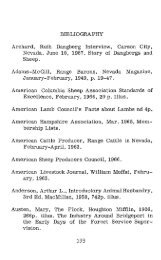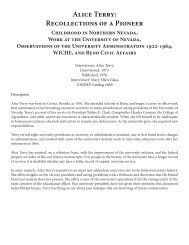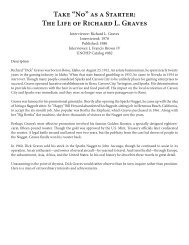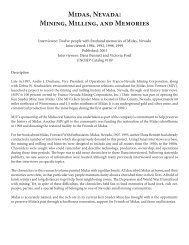Silvio Petricciani - University of Nevada, Reno
Silvio Petricciani - University of Nevada, Reno
Silvio Petricciani - University of Nevada, Reno
You also want an ePaper? Increase the reach of your titles
YUMPU automatically turns print PDFs into web optimized ePapers that Google loves.
86 <strong>Silvio</strong> E. <strong>Petricciani</strong><br />
Now, running a Faro Bank game in the<br />
El Dorado in 1948 and ’49. I think I told you<br />
a little bit about it before. We went down<br />
there with a fifteen thousand dollar bankroll,<br />
which my dad had cosigned a note for us<br />
here at the bank. And we made a deal with<br />
the Moss brothers who owned the El Dorado<br />
Club, and they paid us two thousand dollars<br />
a month. It was a reverse rental. They paid us<br />
two thousand dollars a month to bankroll the<br />
game, furnish the game, the dealers and so on<br />
and so forth and the bankroll. And whatever<br />
we made was ours. The only expenses we had<br />
back to the club, which really wasn’t to the<br />
Mosses because the Silvagnis owned the bar,<br />
and that was the complimentary drinks that<br />
we served to our customers. We bought those<br />
from the bar.<br />
And Faro Bank per se is a lost game. The<br />
percentage <strong>of</strong> the game is so very close that<br />
it’s very difficult to make money with it. You<br />
have to be on top <strong>of</strong> it all the time, and you<br />
have to—I think I explained some <strong>of</strong> the game,<br />
didn’t I?<br />
Some—.<br />
Yes, but it’s a very even game, and many<br />
<strong>of</strong> the expressions that are used in the gaming<br />
business or even outside <strong>of</strong> the gaming<br />
business like—there’s an old expression that<br />
they say, “getting down to cases” which means<br />
getting down to the nitty-gritty. I don’t know<br />
if you ever heard the expression before or<br />
not. But in Faro Bank they have what they<br />
call a casekeeper and that keeps track <strong>of</strong> all<br />
the cards that come out. Casekeeper has the<br />
thirteen cards either engraved in wood on<br />
it or whatever, and it looks like a Chinese<br />
abacus. However, in front <strong>of</strong> each card there’s<br />
four little buttons that you can slide along a<br />
wire, and well, say like on the ace, if the ace<br />
<strong>of</strong> spades shows, why you move that button.<br />
Now the way you move the button is if, we’ll<br />
say the ace <strong>of</strong> spades loses, why then you move<br />
the button completely over until it touches the<br />
back <strong>of</strong> the casekeeper. Now, we’ll say that ace<br />
<strong>of</strong> hearts comes out, and it wins; well, then<br />
you move the next button but you leave an<br />
air space in between the two. And then we’ll<br />
say the ace <strong>of</strong> diamonds loses; then you take<br />
the ace <strong>of</strong> diamonds and put it right next to<br />
the ace <strong>of</strong> hearts, so that your ace <strong>of</strong> spades<br />
you lost is right up against the back <strong>of</strong> the<br />
casekeeper. Then there’s an air space between<br />
the ace <strong>of</strong> hearts and the ace <strong>of</strong> spades because<br />
the ace <strong>of</strong> hearts won.<br />
And you keep track <strong>of</strong> all the cards in the<br />
whole deck that you have in a box, what they<br />
call a Faro box, and you shuffle the cards up<br />
and you shuffle them quite a bit, cut them,<br />
shuffle them; and then you put them in the<br />
box, and you face up. But the only card you<br />
can see is the first card on the deck because it<br />
sits in this little box with a rim around it. Then<br />
that card is the first visible card, and they call<br />
it the soda card. Now why they called it the<br />
soda card I don’t know. I don’t know where<br />
that derived from or anything else. Then what<br />
happens is the next two cards, one will win<br />
and one will lose. So, what you do is take and<br />
you push the soda card <strong>of</strong>f, and you discard it<br />
over to one side. Then the next card—we’ll say<br />
it’s five <strong>of</strong> diamonds—it comes out and falls<br />
down, and you put it right down alongside the<br />
Faro box. That is the losing card, so the five<br />
<strong>of</strong> diamonds lost. And the next card that you<br />
see in the box we’ll say is the nine <strong>of</strong> hearts.<br />
The nine <strong>of</strong> hearts is the winning card. So<br />
on the layout, the Faro Bank layout, you can<br />
bet a card to win or to lose. So, if you bet the<br />
card to win, you place your bet on the card.<br />
If you bet the card to lose, then you put on<br />
there what you call a copper which is a little<br />
octagon black piece <strong>of</strong> wood about a quarter<br />
<strong>of</strong> an inch thick. It has a little design on it and
















